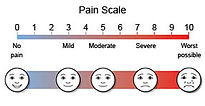Title of page

Chronic Pain Management
Facts:
❱ Pain is a major health and economic issue in the United States and the number one cause of adult disability.
❱ There are currently more than 100 million Americans suffering from chronic pain, including 65% to 80% of terminal cancer patients, 62% of nursing home residents, and many others who must manage pain on a daily basis.
❱ Chronic pain affects more people than diabetes, coronary heart disease, stroke, and cancer combined.
❱ Pain costs an estimated $560 billion to $635 billion annually in lost workdays, medical expenses, and other benefit costs.
❱ Unrelieved pain can result in longer hospital stays, increased rates of re-hospitalization, increased outpatient visits, and decreased ability to function fully leading to lost income and insurance coverage.
❱ Unrelieved chronic pain problems often result in an inability for patients to work and maintain health insurance. Chronic pain is the most common cause of disability, partially or totally disabling 50 million people in the U.S.
Our board Certified Clinical Pharmacist Practitioners, physicians and other providers will collaborate to
-
Evaluate and manage your chronic pain based on clinical practice guidelines.
-
Assess for other alternatives (such as aquatic physical therapy, auricular acupuncture, meditation and mindfulness, integrate biomedicine with the nature of healing, etc.) for pain management.
-
Optimize medications including opioid use through comprehensive therapeutic review and personalized medicine utilizing pharmacogenomics and nutrigenomics.
-
Recommend and individualize pain goals based on patient‐specific need.
-
Engage patient for self-care and adherence.
-
Formulate patient‐centered treatment plans for complex patients with pain.
Management of pain:
❱ includes medicines (prescription pain medication - opioids or narcotics, muscle relaxers, steroids, anesthetics, anxiety/antidepressants, anticonvulsants; over- the-counter medication – Tylenol, NSAIDs, pain cream, gel, patch) and interventional treatment by pain physician.
❱ includes non-pharmacological treatment such as physical therapy, massage therapy, ultrasound, acupuncture, exercise, biofeedback, electrical stimulation (transcutaneous electrical or spinal cord stimulation).
❱ improves physical and emotional health (depression, anxiety), sleep, daily activity, mood and relationship.
❱ Pain is multidimensional with psychosocial, behavioral, spiritual, and genetic variables.
❱ Patients have the right to safe and effective pain control.
❱ Pharmacists are an integral and accountable part of the care of the patient in pain.
❱ Patients experience a decrease in the incidence of adverse events and improvements in their satisfaction with care with Pharmacist's interventions.
❱ Pharmacists help patients understand the appropriate use of the medications and periodically assess them to ensure that pain management goals are being adequately achieved.
❱ Pharmacists establish a professional relationship to better understand patients’ needs and challenges in treating their pain.
❱ Pharmacists act as an advocate and a partner when communicating with prescribers.

Tips to manage pain:
❱ Keep a pain diary, maintain a goal pain scale.
❱ Apply heat or ice as directed; sleep in comfortable position.
❱ If indicated and possible elevate the painful area above the level of heart.
❱ Apply compression with an elastic bandage or abdominal binder as directed.
❱ Use assistive devices (splint, cane, crutches, walker, knee sleeves and braces, arch supports and orthotics) if indicated.
❱ Exercise (Yoga, Ti-Chi), rehab, aromatherapy, self-hypnosis, guided imagery, meditation.
❱ Discuss with your pain pharmacist and physician about daily activities, over the counter and prescription medications you take.





Our Understanding of Pain has Evolved


